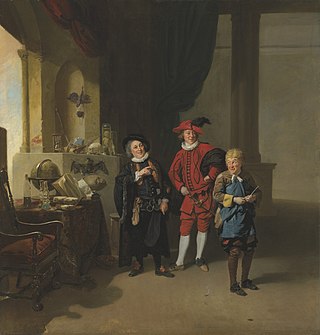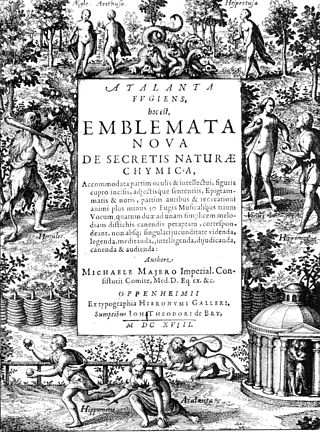Related Research Articles

The phoenix is an immortal bird that cyclically regenerates or is otherwise born again. While it is part of Greek mythology, it has analogs in many cultures, such as Egyptian and Persian mythology. Associated with the sun, a phoenix obtains new life by rising from the ashes of its predecessor. Some legends say it dies in a show of flames and combustion, while others that it simply dies and decomposes before being born again. In the Motif-Index of Folk-Literature, a tool used by folklorists, the phoenix is classified as motif B32.

A clef is a musical symbol used to indicate which notes are represented by the lines and spaces on a musical staff. Placing a clef on a staff assigns a particular pitch to one of the five lines or four spaces, which defines the pitches on the remaining lines and spaces.
The musical term alto, meaning "high" in Italian, historically refers to the contrapuntal part higher than the tenor and its associated vocal range. In 4-part voice leading alto is the second-highest part, sung in choruses by either low women's or high men's voices. In vocal classification these are usually called contralto and male alto or countertenor.
Argenis is a book by John Barclay. It is a work of historical allegory which tells the story of the religious conflict in France under Henry III of France and Henry IV of France, and also touches on more contemporary English events, such as the Overbury scandal. The tendency is royalist, anti-aristocratic; it is told from the angle of a king who reduces the landed aristocrats' power in the interest of the "country", the interest of which is identified with that of the king.

Michael Maier was a German physician and counsellor to Rudolf II Habsburg. He was a learned alchemist, epigramist, and amateur composer.
James Dillon is a Scottish composer who is often regarded as belonging to the New Complexity school. Dillon studied art and design, linguistics, piano, acoustics, Indian rhythm, mathematics and computer music, but is self-taught in composition.

The Orgelbüchlein BWV 599−644 is a set of 46 chorale preludes for organ — one of them is given in two versions — by Johann Sebastian Bach. All but three were written between 1708 and 1717 when Bach served as organist to the ducal court in Weimar; the remainder and a short two-bar fragment came no earlier than 1726, after the composer’s appointment as cantor at the Thomasschule in Leipzig.
Adam McLean is a Scottish writer on alchemical texts and symbolism. In 1978 he founded the Hermetic Journal which he published until 1992 during which time he also started publishing the Magnum Opus Hermetic Sourceworks, a series of 55 editions of key source texts of the hermetic tradition. From 2004 he began collecting tarot cards in order to document tarot art and built up a collection of 2500 items. In 2016 he set up the Surrealism Website in order to document surrealist painters. This currently shows the work of 100 surrealist artists. He also created a series of 20 video lectures on many facets of surrealist paintings. In 2017 he set up an art gallery The Studio and Gallery in Kilbirnie in North Ayrshire in order to promote the work of emergent and lesser-known artists. In 2023 McLean began publishing, in book form, his Alchemical Translations Series of translations of 16-18th Century German, Latin and French alchemical works previously unavailable in English. This project is intended to expand the public's perception of the richness of alchemical literature.
Cesare Ripa was an Italian iconographer who worked for Cardinal Anton Maria Salviati as a cook and butler.

Alchemy has had a long-standing relationship with art, seen both in alchemical texts and in mainstream entertainment. Literary alchemy appears throughout the history of English literature from Shakespeare to modern Fantasy authors. Here, characters or plot structure follow an alchemical magnum opus. In the fourteenth century, Chaucer began a trend of alchemical satire that can still be seen in recent fantasy works like those of Terry Pratchett.
The Phoenix is an anonymous Old English poem. It is composed of 677 lines and is for the most part a translation and adaptation of the Latin poem De Ave Phoenice attributed to Lactantius. It is found in the Exeter Book.
Rebelión is a nonprofit news site, started in Spain at the end of 1996 by a group of journalists. It contains scientific and opinion articles covering topics such as current affairs, free knowledge, culture, ecology, economics, and resistance to globalization. Texts by, and translations into Spanish from, authors such as Heinz Dieterich, Noam Chomsky, Marta Harnecker, Eduardo Galeano, José Saramago, Gabriel García Márquez, Julio Anguita, Vicenç Navarro and Ralph Nader have been included in Rebelión.

Unser Mund sei voll Lachens, BWV 110, is a church cantata by Johann Sebastian Bach. He composed the Christmas cantata in Leipzig for Christmas Day and first performed it on 25 December 1725.

Messiah, the English-language oratorio composed by George Frideric Handel in 1741, is structured in three parts. This listing covers Part II in a table and comments on individual movements, reflecting the relation of the musical setting to the text. Part I begins with the prophecy of the Messiah and his birth, shows the annunciation to the shepherds and reflects the Messiah's deeds on earth. Part II covers the Passion in nine movements including the oratorio's longest movement, an air for alto He was despised, then mentions death, resurrection, ascension, and reflects the spreading of the Gospel and its rejection. The part is concluded by a scene called "God's Triumph" that culminates in the Hallelujah chorus. Part III of the oratorio concentrates on Paul's teaching of the resurrection of the dead and Christ's glorification in heaven.

Messiah, the English-language oratorio composed by George Frideric Handel in 1741, is structured in three parts. This listing covers Part III in a table and comments on individual movements, reflecting the relation of the musical setting to the text. Part I begins with the prophecy of the Messiah and his birth, shows the annunciation to the shepherds as a scene from the Gospel of Luke, and reflects the Messiah's deeds on Earth. Part II covers the Passion, death, resurrection, ascension, and the later spreading of the Gospel. Part III concentrates on Paul's teaching of the resurrection of the dead and Christ's glorification in heaven.

The Mass in B minor is Johann Sebastian Bach's only setting of the complete Latin text of the Ordinarium missae. Towards the end of his life, mainly in 1748 and 1749, he finished composing new sections and compiling it into a complex, unified structure.

Atalanta Fugiens or Atalanta Fleeing is an emblem book with an alchemical theme by Michael Maier (1568–1622), published by Johann Theodor de Bry in Oppenheim in 1617. It consists of 50 discourses with illustrations by Matthias Merian, each of which is accompanied by an epigrammatic verse, prose and a musical fugue. It may therefore be considered an early example of multimedia.

The Magnificat in E-flat major, BWV 243a, also BWV 243.1, by Johann Sebastian Bach is a musical setting of the Latin text of the Magnificat, Mary's canticle from the Gospel of Luke. It was composed in 1723 and is in twelve movements, scored for five vocal parts and a Baroque orchestra of trumpets, timpani, oboes, strings and basso continuo including bassoon. Bach revised the work some ten years later, transposing it from E-flat major to D major, and creating the version mostly performed today, BWV 243.

Septimana Philosophica or The Philosophical Week is an alchemical book written by Michael Maier. It was published by Lucas Jennis in 1620 in Frankfurt and printed by Hartmann Palthenius. The title page was engraved by Balthasar Schwan. The full title of the book is Septimana Philosophica: Qua Aenigmata Aureola de omni Naturae genere a Solomone Israelitarum Sapientissimo Rege, et Arabiae Regina Saba, nec non Hyramo, Tyri Principe, sibi invicem in modum Colloquii proponuntur et enodatur.

Tripus Aureus or The Golden Tripod is an alchemical book by Michael Maier published in 1618 by Lucas Jennis. It contains three alchemical texts: The "twelve keys" of Basil Valentine, Thomas Norton's Ordinal of Alchemy (1477), and The Testament of Cremer.
References
- 1 2 3 4 Mike Dickman. Intellectual Cantilenae in Nine Triads upon the Resurrection of the Phoenix by Michael Maier. p.35-36. Adam McLean. Glasgow. 1992. ASIN: B001ACAK7U
- 1 2 James Brown Craven. Count Michael Maier - Life and Writings. Kirkwall. 1910
- ↑ Erik Leibenguth. Hermetische Poesie des Frühbarock: Die "Cantilenae intellectuales" Michael Maiers. Edition mit Übersetzung, Kommentar und Bio-Bibliographie. Walter de Gruyter GmbH & Co KG, January 1, 2002.